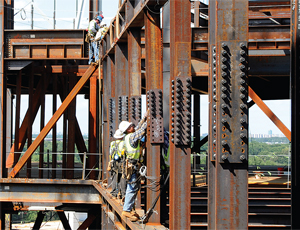The confluence of two wars, the growth and reorganization of the U.S. Army and the enormous construction program required to accommodate those demands are the forces driving the federal government’s construction workhorse, the U.S. Army Corps of Engineers, through its own transformation to become a more efficient program-management machine.
Fiscal year 2009, from Oct. 1, 2008, to Sept. 30, 2009, “was one of the largest military programs ever” for the Corps, says Lt. Gen. Robert L. Van Antwerp, its chief. Including construction driven by the 2005 Base Realignment and Closure Act (BRAC), $3 billion in American Recovery and Reinvestment Act projects, as well as a facilities sustainment, restoration and modernization program, among other work, the Corps was responsible for a worldwide military construction program exceeding $32 billion in 2009 alone. That is twice the project value it handled four years ago, “all of which is being executed by approximately the same level” of Corps staffing, Van Antwerp says.

Twice the project value with the same sized management team is a good metric, and in an e-mail exchange, Van Antwerp offers other promising metrics based on changes between 2005 and 2009 in completed construction dates, escalation of project cost and time of construction. Citing “standard Corps performance metrics,” the rate of construction cost growth, including user changes, was reduced to 3.3% from 6%; contract time growth dropped to 17.6% from 30.1%; and slip of the beneficial occupancy date fell to 9.4% from 10.5%, Van Antwerp says.
From 2005 through 2010, the Corps project list shows $51.3 billion in project value on the books. Van Antwerp says the Corps has 725 projects under construction with a combined contract value of $20.4 billion. FY08 and FY09 projects share the bulk of the load, and the trend toward greater efficiency continues.
“The average project cost growth at the end of fiscal 2009 for these ongoing construction projects is approximately 1.5%,” Van Antwerp says. “In light of the increases in program, project values and volume, the changes implemented by the Corps since 2005 have distinctly improved efficiency and project delivery.”
Early this decade, when the Corps saw a storm of work approaching from global war on terror funding, plans for BRAC 2005 and moves to shift European-based troops back to the States, it was getting its arms around more flexible delivery tools like design-build and construction management at-risk, which it calls early contractor involvement, or ECI.
“We could see, to balance all the requirements simultaneously and meet the BRAC requirements, we couldn’t operate sequentially,” says Maj. Gen. Merdith W. B. “Bo” Temple, deputy commanding general for Corps civil and emergency operations. The Federal Acquisition Regulations also were changed in the mid-1990s, opening the door for districts to use different delivery tools, too, says Richmond Kendrick, deputy of program execution for the Corps’ Hurricane Protection Office (HPO) in New Orleans.
Temple’s previous assignment with the Corps as head of military programs, where he was in charge of $20 billion in design, construction and environmental programs, as well as earlier assignments, have given him a lead role in MILCON Transformation—a program launched to re-engineer Corps processes and procedures to deliver billions of dollars worth in BRAC and MILCON work by 2013.
However, like most things in the military, the changes started in the field when districts were challenged to deliver a deluge of work, says Mike Rossi, chief operating officer of Vali Cooper International LLC, Madisonville, La., and...

















Post a comment to this article
Report Abusive Comment